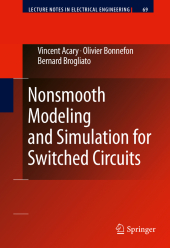 Neuerscheinungen 2012Stand: 2020-01-07 |
Schnellsuche
ISBN/Stichwort/Autor
|
Herderstraße 10
10625 Berlin
Tel.: 030 315 714 16
Fax 030 315 714 14
info@buchspektrum.de |

Vincent Acary, Olivier Bonnefon, Bernard Brogliato
(Beteiligte)
Nonsmooth Modeling and Simulation for Switched Circuits
2012. xxiii, 284 S. XXIII, 284 p. 235 mm
Verlag/Jahr: SPRINGER NETHERLANDS; SPRINGER, BERLIN 2012
ISBN: 9400733852 (9400733852)
Neue ISBN: 978-9400733855 (9789400733855)
Preis und Lieferzeit: Bitte klicken
Complete with examples and simulation results, this volume explores the nonsmooth dynamical systems (NSDS) modeling approach, using piecewise-linear and multivalued models of electronic devices. Readers will find a comparison of SPICE and hybrid methods, which demonstrates the power of the NSDS approach.
Nonsmooth Modeling and Simulation for Switched Circuits concerns the modeling and the numerical simulation of switched circuits with the nonsmooth dynamical systems (NSDS) approach, using piecewise-linear and multivalued models of electronic devices like diodes, transistors, switches. Numerous examples (ranging from introductory academic circuits to various types of power converters) are analyzed and many simulation results obtained with the INRIA open-source SICONOS software package are presented. Comparisons with SPICE and hybrid methods demonstrate the power of the NSDS approach. Nonsmooth Modeling and Simulation for Switched Circuits is intended to researchers and engineers in the field of circuits simulation and design, but may also attract applied mathematicians interested by the numerical analysis for nonsmooth dynamical systems, as well as researchers from Systems and Control.
Part I Theoretical Framework
1 Switched Circuits. 1.1 Simple examples of switched circuits. 1.2 A unified dynamical framework: Lur´e dynamical systems. 1.3 An aside on nonsmooth mechanics: the bouncing ball. 1.4 Conclusions. 1.5 Historical summary.
2 Mathematical Background. 2.1 Basics from convex and nonsmooth analysis. 2.2 Non convex sets. 2.3 Basics from complementarity theory. 2.4 Mathematical formalisms. 2.5 The dynamics of the simple circuits. 2.6 Time-discretization schemes. 2.7 Conclusions and recapitulation.
Part II Dynamics Generation and Numerical Algorithms.
3 Conventional Circuit Equation Formulation and Simulation. 3.1 Circuit topology and Kirchhoff´s laws. 3.2 The Sparse Tableau Analysis (STA). 3.3 The Modified Nodal Analysis. 3.4 The charge/flux oriented MNA. 3.5 Standard Differential Algebraic Equation (DAE)s stemming from the MNA. 3.6 Semi-explicit Differential Algebraic Equation (DAE) forms. 3.7 Basics on standard circuit simulation.
4 Nonsmooth Modeling of Electrical Components. 4.1 General nonsmooth electrical element. 4.2 Nonsmooth elements as inclusions into the subdifferential of convex functions and Variational Inequality (VI). 4.3 Nonsmooth elements as inclusions into normal cones and variational inequalities. 4.4 Complementarity problems. 4.5 The linear Input/Output relation case. 4.6 Generic piecewise-linear components. 4.7 Special instances of nonsmooth components.
5 Time-stepping Schemes and One Step Solvers. 5.1 Summary of the mathematical formalisms. 5.2 Principles of the numerical time-integration scheme. 5.3 Time-discretization of the general cases. 5.4 One-step NonSmooth Problems (OSNSP) solvers.
Part III Numerical Simulations.
6 The ACEF module and the software. 6.1 An Insight into SICONOS. 6.2 SICONOS software. 6.3 The Automatic Circuit Equations Formulation (ACEF) module and algorithms.
7 Simple Circuits. 7.1 Maffezzoni´s example. 7.2 A first diode-bridge wave rectifier. 7.3 A second diode-bridge wave rectifier. 7.4 The Cuk converter. 7.5 A circuit exhibiting sliding modes.
8 Buck and Delta-Sigma Converters. 8.1 The buck converter with load resistor. 8.2 The buck converter loaded by a resistor and an inverter chain. 8.3 The Delta-Sigma converter. 8.4 Conclusions.
A Some Facts in Real Analysis. A.1 Absolutely continuous functions and sets. A.2 Lipschitz continuous functions and sets. A.3 Functions of bounded variations in time. A.4 Multifunctions of bounded variation in time. A.5 Differential measures. A.6 Measure Differential Inclusion (MDI).
References. Index.


